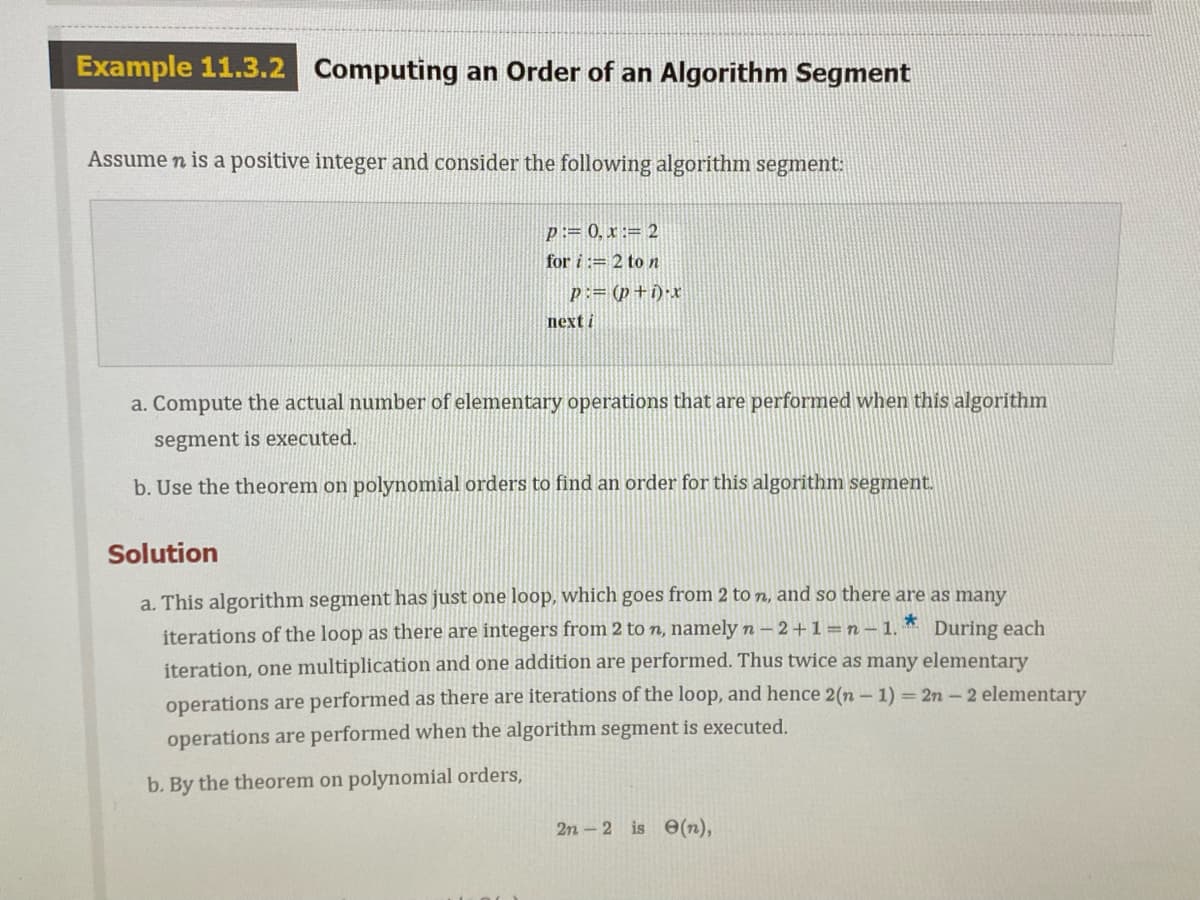answer
Computer Networking: A Top-Down Approach (7th Edition)
7th Edition
ISBN:9780133594140
Author:James Kurose, Keith Ross
Publisher:James Kurose, Keith Ross
Chapter1: Computer Networks And The Internet
Section: Chapter Questions
Problem R1RQ: What is the difference between a host and an end system? List several different types of end...
Related questions
Question
Please help me with this!! Please box the answer!
![Consider the following algorithm segment. Assume that n is a positive integer such that n 2 6.
max := a[4]
for i := 5 ton
if max < a[i] then max := a[i]
next i
(a) What is the actual number of elementary operations (additions, subtractions, multiplications, divisions, and comparisons)
that are performed when the algorithm segment is executed? For simplicity, count only comparisons that occur within if-then
statements, and ignore those implied by for-next loops. Express your answer in terms of n. (Hint: See Example 11.3.2 and
Exercise 11.3.6a in the "Read It" link.)
The number of operations is
(b) Apply the theorem on polynomial orders to the expression in part (a) to find that an order for the algorithm segment is
n](/v2/_next/image?url=https%3A%2F%2Fcontent.bartleby.com%2Fqna-images%2Fquestion%2Ff3338d11-e357-46a6-a0cb-2acef02ee9e6%2F933b4923-ddb6-421a-8602-2b158f817600%2F3aaap4_processed.jpeg&w=3840&q=75)
Transcribed Image Text:Consider the following algorithm segment. Assume that n is a positive integer such that n 2 6.
max := a[4]
for i := 5 ton
if max < a[i] then max := a[i]
next i
(a) What is the actual number of elementary operations (additions, subtractions, multiplications, divisions, and comparisons)
that are performed when the algorithm segment is executed? For simplicity, count only comparisons that occur within if-then
statements, and ignore those implied by for-next loops. Express your answer in terms of n. (Hint: See Example 11.3.2 and
Exercise 11.3.6a in the "Read It" link.)
The number of operations is
(b) Apply the theorem on polynomial orders to the expression in part (a) to find that an order for the algorithm segment is
n

Transcribed Image Text:Example 11.3.2
Computing an Order of an Algorithm Segment
Assume n is a positive integer and consider the following algorithm segment:
p:= 0, x := 2
for i := 2 to n
p:= (p+i)•x
next i
a. Compute the actual number of elementary operations that are performed when this algorithm
segment is executed.
b. Use the theorem on polynomial orders to find an order for this algorithm segment.
Solution
a. This algorithm segment has just one loop, which goes from 2 to n, and so there are as many
iterations of the loop as there are integers from 2 to n, namely n – 2+1=n- 1.
During each
iteration, one multiplication and one addition are performed. Thus twice as many elementary
operations are performed as there are iterations of the loop, and hence 2(n – 1) = 2n- 2 elementary
operations are performed when the algorithm segment is executed.
b. By the theorem on polynomial orders,
2n - 2 is 6(n),
Expert Solution
This question has been solved!
Explore an expertly crafted, step-by-step solution for a thorough understanding of key concepts.
Step by step
Solved in 2 steps with 3 images

Recommended textbooks for you

Computer Networking: A Top-Down Approach (7th Edi…
Computer Engineering
ISBN:
9780133594140
Author:
James Kurose, Keith Ross
Publisher:
PEARSON

Computer Organization and Design MIPS Edition, Fi…
Computer Engineering
ISBN:
9780124077263
Author:
David A. Patterson, John L. Hennessy
Publisher:
Elsevier Science

Network+ Guide to Networks (MindTap Course List)
Computer Engineering
ISBN:
9781337569330
Author:
Jill West, Tamara Dean, Jean Andrews
Publisher:
Cengage Learning

Computer Networking: A Top-Down Approach (7th Edi…
Computer Engineering
ISBN:
9780133594140
Author:
James Kurose, Keith Ross
Publisher:
PEARSON

Computer Organization and Design MIPS Edition, Fi…
Computer Engineering
ISBN:
9780124077263
Author:
David A. Patterson, John L. Hennessy
Publisher:
Elsevier Science

Network+ Guide to Networks (MindTap Course List)
Computer Engineering
ISBN:
9781337569330
Author:
Jill West, Tamara Dean, Jean Andrews
Publisher:
Cengage Learning

Concepts of Database Management
Computer Engineering
ISBN:
9781337093422
Author:
Joy L. Starks, Philip J. Pratt, Mary Z. Last
Publisher:
Cengage Learning

Prelude to Programming
Computer Engineering
ISBN:
9780133750423
Author:
VENIT, Stewart
Publisher:
Pearson Education

Sc Business Data Communications and Networking, T…
Computer Engineering
ISBN:
9781119368830
Author:
FITZGERALD
Publisher:
WILEY